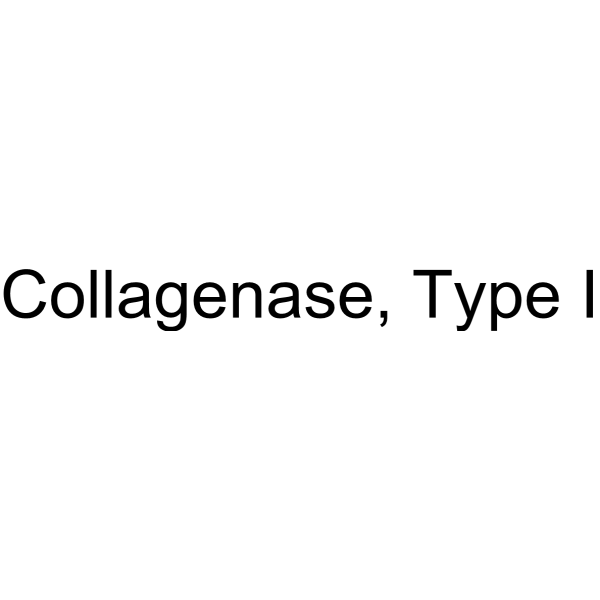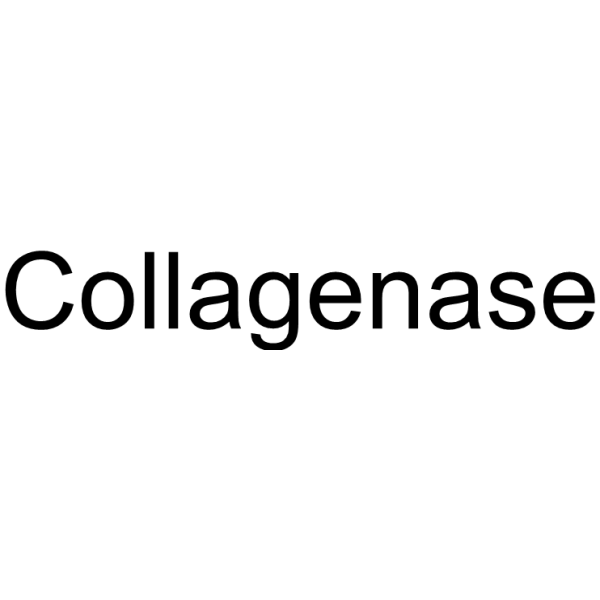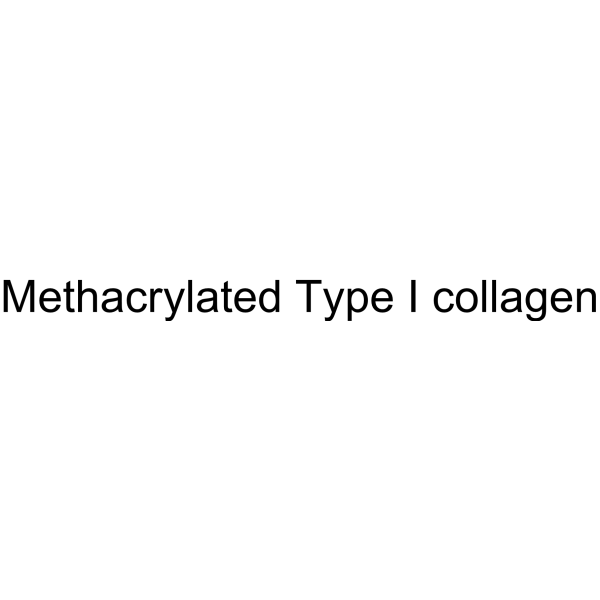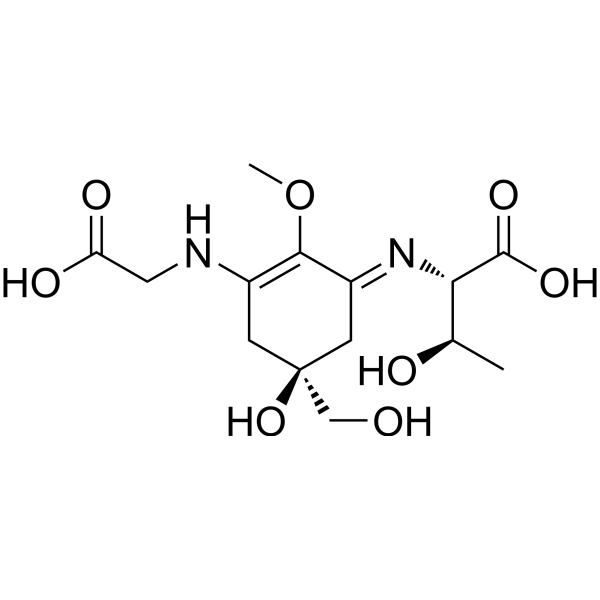Search Result
Results for "
type I collagen
" in MedChemExpress (MCE) Product Catalog:
1
Biochemical Assay Reagents
| Cat. No. |
Product Name |
Target |
Research Areas |
Chemical Structure |
-
- HY-E70005A
-
|
EC 3.4.24.3
|
Biochemical Assay Reagents
|
Others
|
Collagenase, Type I is a microbially derived matrix metalloproteinases (MMPs) and zinc peptidase. Collagenase, Type I breaks down collagens 1, 3, 7, 8, 10, gelatin, proteoglycans, aggrecan .
|
-

-
- HY-O0004
-
|
|
|
|
|
Collagenases are enzymes that break the peptide bonds in collagen. Collagenases are derived from the Clostridium histolyticum. Collagenases (Type I) are proteolytic enzymes that break peptide bonds in collagen and can be used for tissue digestion and dissociation.
|
-

-
- HY-N0331
-
|
|
MDM-2/p53
Apoptosis
|
Cancer
|
|
Ziyuglycoside I isolated from S. officinalis root, has anti-wrinkle activity, and increases the expression of type I collagen. Ziyuglycoside I could be used as an active ingredient for cosmetics . Ziyuglycoside I triggers cell cycle arrest and apoptosis mediated by p53, it can be a potential agent candidate for treating triple-negative breast cancer (TNBC) .
|
-

-
- HY-158225
-
|
Col1MA
|
Biochemical Assay Reagents
|
Others
|
|
Methacrylated Type I collagen (Col1MA) is a methacrylated tissue engineering scaffold material. Methacrylated Type I collagen retains the essential properties of natural collagen, including spontaneous fiber self-assembly and enzymatic biodegradability. Methacrylated Type I collagen is capable of self-assembly into fibrous hydrogels, intrinsic support of tissue cells through bioactive adhesion sites, and its biodegradability. After photo-cross-linking CMA, the cell viability of encapsulated mesenchymal stem cells was protected .
|
-

-
- HY-126956
-
-

-
- HY-N1584
-
|
RU-19110
|
DNA/RNA Synthesis
TGF-beta/Smad
Parasite
Sodium Channel
Calcium Channel
|
Infection
Cardiovascular Disease
Inflammation/Immunology
Cancer
|
|
Halofuginone (RU-19110), a Febrifugine derivative, is a competitive prolyl-tRNA synthetase inhibitor with a Ki of 18.3 nM . Halofuginone is a specific inhibitor of type-I collagen synthesis and attenuates osteoarthritis (OA) by inhibition of TGF-β activity . Halofuginone is also a potent pulmonary vasodilator by activating Kv channels and blocking voltage-gated, receptor-operated and store-operated Ca 2+ channels. Halofuginone has anti-malaria, anti-inflammatory, anti-cancer, anti-fibrosis effects .
|
-

-
- HY-N1584A
-
|
RU-19110 hydrobromide
|
DNA/RNA Synthesis
TGF-beta/Smad
Parasite
Sodium Channel
Calcium Channel
|
Infection
Cardiovascular Disease
Inflammation/Immunology
Cancer
|
|
Halofuginone (RU-19110) hydrobromid, a Febrifugine derivative, is a competitive prolyl-tRNA synthetase inhibitor with a Ki of 18.3 nM . Halofuginone hydrobromid is a specific inhibitor of type-I collagen synthesis and attenuates osteoarthritis (OA) by inhibition of TGF-β activity . Halofuginone hydrobromid is also a potent pulmonary vasodilator by activating Kv channels and blocking voltage-gated, receptor-operated and store-operated Ca 2+ channels. Halofuginone hydrobromid has anti-malaria, anti-inflammatory, anti-cancer, anti-fibrosis effects .
|
-

-
- HY-N1584B
-
|
RU-19110 hydrochloride
|
Calcium Channel
DNA/RNA Synthesis
Parasite
Sodium Channel
TGF-beta/Smad
|
Infection
Cardiovascular Disease
Inflammation/Immunology
Cancer
|
|
Halofuginone (RU-19110) hydrobromid, a Febrifugine derivative, is a competitive prolyl-tRNA synthetase inhibitor with a Ki of 18.3 nM. Halofuginone hydrobromid is a specific inhibitor of type-I collagen synthesis and attenuates osteoarthritis (OA) by inhibition of TGF-β activity. Halofuginone hydrobromid is also a potent pulmonary vasodilator by activating Kv channels and blocking voltage-gated, receptor-operated and store-operated Ca 2+ channels. Halofuginone hydrobromid has anti-malaria, anti-inflammatory, anti-cancer, anti-fibrosis effects .
|
-

-
- HY-13948
-
|
Angiotensin II; Ang II; DRVYIHPF
|
Angiotensin Receptor
Apoptosis
|
Cardiovascular Disease
Endocrinology
Cancer
|
|
Angiotensin II (Angiotensin II) is a vasoconstrictor and a major bioactive peptide of the renin/angiotensin system. Angiotensin II human plays a central role in regulating human blood pressure, which is mainly mediated by interactions between Angiotensin II and the G-protein-coupled receptors (GPCRs) Angiotensin II type 1 receptor (AT1R) and Angiotensin II type 2 receptor (AT2R). Angiotensin II human stimulates sympathetic nervous stimulation, increases aldosterone biosynthesis and renal actions. Angiotensin II human induces growth of vascular smooth muscle cells, increases collagen type I and III synthesis in fibroblasts, leading to thickening of the vascular wall and myocardium, and fibrosis. Angiotensin II human also induces apoptosis. Angiotensin II induces capillary formation from endothelial cells via the LOX-1 dependent redox-sensitive pathway .
|
-

-
- HY-13948A
-
|
Angiotensin II acetate; Ang II acetate; DRVYIHPF acetate
|
Angiotensin Receptor
Apoptosis
|
Cardiovascular Disease
Endocrinology
Cancer
|
|
Angiotensin II human (Angiotensin II) acetate is a vasoconstrictor and a major bioactive peptide of the renin/angiotensin system. Angiotensin II human acetate plays a central role in regulating human blood pressure, which is mainly mediated by interactions between Angiotensin II and the G-protein-coupled receptors (GPCRs) Angiotensin II type 1 receptor (AT1R) and Angiotensin II type 2 receptor (AT2R). Angiotensin II human acetate stimulates sympathetic nervous stimulation, increases aldosterone biosynthesis and renal actions. Angiotensin II human acetate induces growth of vascular smooth muscle cells, increases collagen type I and III synthesis in fibroblasts, leading to thickening of the vascular wall and myocardium, and fibrosis. Angiotensin II human acetate also induces apoptosis. Angiotensin II human acetate induces capillary formation from endothelial cells via the LOX-1 dependent redox-sensitive pathway .
|
-

-
- HY-13948B
-
|
Angiotensin II TFA; Ang II TFA; DRVYIHPF TFA
|
Angiotensin Receptor
Apoptosis
|
Cardiovascular Disease
Endocrinology
Cancer
|
|
Angiotensin II human (Angiotensin II) TFA is a vasoconstrictor and a major bioactive peptide of the renin/angiotensin system. Angiotensin II human TFA plays a central role in regulating human blood pressure, which is mainly mediated by interactions between Angiotensin II and the G-protein-coupled receptors (GPCRs) Angiotensin II type 1 receptor (AT1R) and Angiotensin II type 2 receptor (AT2R). Angiotensin II human TFA stimulates sympathetic nervous stimulation, increases aldosterone biosynthesis and renal actions. Angiotensin II human TFA induces growth of vascular smooth muscle cells, increases collagen type I and III synthesis in fibroblasts, leading to thickening of the vascular wall and myocardium, and fibrosis. Angiotensin II human TFA also induces apoptosis. Angiotensin II human TFA induces capillary formation from endothelial cells via the LOX-1 dependent redox-sensitive pathway .
|
-

| Cat. No. |
Product Name |
Type |
-
- HY-158225
-
|
Col1MA
|
3D Bioprintig
|
|
Methacrylated Type I collagen (Col1MA) is a methacrylated tissue engineering scaffold material. Methacrylated Type I collagen retains the essential properties of natural collagen, including spontaneous fiber self-assembly and enzymatic biodegradability. Methacrylated Type I collagen is capable of self-assembly into fibrous hydrogels, intrinsic support of tissue cells through bioactive adhesion sites, and its biodegradability. After photo-cross-linking CMA, the cell viability of encapsulated mesenchymal stem cells was protected .
|
| Cat. No. |
Product Name |
Target |
Research Area |
-
- HY-P1912
-
|
|
Peptides
|
Endocrinology
|
|
Alpha 1(I) Collagen (614-639), human is a peptide fragment of alpha-1 type I collagen.
|
-
- HY-13948
-
|
Angiotensin II; Ang II; DRVYIHPF
|
Angiotensin Receptor
Apoptosis
|
Cardiovascular Disease
Endocrinology
Cancer
|
|
Angiotensin II (Angiotensin II) is a vasoconstrictor and a major bioactive peptide of the renin/angiotensin system. Angiotensin II human plays a central role in regulating human blood pressure, which is mainly mediated by interactions between Angiotensin II and the G-protein-coupled receptors (GPCRs) Angiotensin II type 1 receptor (AT1R) and Angiotensin II type 2 receptor (AT2R). Angiotensin II human stimulates sympathetic nervous stimulation, increases aldosterone biosynthesis and renal actions. Angiotensin II human induces growth of vascular smooth muscle cells, increases collagen type I and III synthesis in fibroblasts, leading to thickening of the vascular wall and myocardium, and fibrosis. Angiotensin II human also induces apoptosis. Angiotensin II induces capillary formation from endothelial cells via the LOX-1 dependent redox-sensitive pathway .
|
-
- HY-13948A
-
|
Angiotensin II acetate; Ang II acetate; DRVYIHPF acetate
|
Angiotensin Receptor
Apoptosis
|
Cardiovascular Disease
Endocrinology
Cancer
|
|
Angiotensin II human (Angiotensin II) acetate is a vasoconstrictor and a major bioactive peptide of the renin/angiotensin system. Angiotensin II human acetate plays a central role in regulating human blood pressure, which is mainly mediated by interactions between Angiotensin II and the G-protein-coupled receptors (GPCRs) Angiotensin II type 1 receptor (AT1R) and Angiotensin II type 2 receptor (AT2R). Angiotensin II human acetate stimulates sympathetic nervous stimulation, increases aldosterone biosynthesis and renal actions. Angiotensin II human acetate induces growth of vascular smooth muscle cells, increases collagen type I and III synthesis in fibroblasts, leading to thickening of the vascular wall and myocardium, and fibrosis. Angiotensin II human acetate also induces apoptosis. Angiotensin II human acetate induces capillary formation from endothelial cells via the LOX-1 dependent redox-sensitive pathway .
|
-
- HY-P4812
-
|
|
Peptides
|
Metabolic Disease
|
|
Prepro-von Willebrand factor (641-650) (bovine) is a fragment of Prepro-von Willebrand factor, which binds to type I collagen .
|
-
- HY-P0284
-
|
|
Peptides
|
Inflammation/Immunology
|
|
C-telopeptide, a cross-linked peptide of type I collagen, is released during bone resorption and has been correlated with bone mineral density (BMD).
|
-
- HY-13948B
-
|
Angiotensin II TFA; Ang II TFA; DRVYIHPF TFA
|
Angiotensin Receptor
Apoptosis
|
Cardiovascular Disease
Endocrinology
Cancer
|
|
Angiotensin II human (Angiotensin II) TFA is a vasoconstrictor and a major bioactive peptide of the renin/angiotensin system. Angiotensin II human TFA plays a central role in regulating human blood pressure, which is mainly mediated by interactions between Angiotensin II and the G-protein-coupled receptors (GPCRs) Angiotensin II type 1 receptor (AT1R) and Angiotensin II type 2 receptor (AT2R). Angiotensin II human TFA stimulates sympathetic nervous stimulation, increases aldosterone biosynthesis and renal actions. Angiotensin II human TFA induces growth of vascular smooth muscle cells, increases collagen type I and III synthesis in fibroblasts, leading to thickening of the vascular wall and myocardium, and fibrosis. Angiotensin II human TFA also induces apoptosis. Angiotensin II human TFA induces capillary formation from endothelial cells via the LOX-1 dependent redox-sensitive pathway .
|
| Cat. No. |
Product Name |
Target |
Research Area |
-
- HY-P990251
-
|
|
Inhibitory Antibodies
|
Others
|
|
Anti-Human/Mouse denatured collagen type-I Antibody (XL313) is a mouse-derived IgG1, κ type antibody inhibitor, targeting to human/mouse denatured collagen type-I.
|
| Cat. No. |
Product Name |
Category |
Target |
Chemical Structure |
| Cat. No. |
Product Name |
Application |
Reactivity |
-
- HY-P81227
-
|
collagen type I; Alpha 1 type I collagen; Alpha 2 type I collagen; COL1A1; COL1A2; collagen I alpha 1 polypeptide; collagen I alpha 2 polypeptide; collagen Of Skin Tendon And Bone; collagen type 1; collagen type I alpha 1; collagen type I alpha 2; OI4; Osteogenesis Imperfecta type IV; Pro alpha 1(I) collagen; type I procollagen; CO1A1_HUMAN.
|
WB; ELISA; IHC-P; IHC-F; Flow-Cyt; IF
|
Human, Mouse, Rat, Rabbit(predicted: Chicken, Dog, Cow, Sheep) |
|
Collagen I Antibody is an unconjugated, approximately 130 kDa, rabbit-derived, anti-Collagen I polyclonal antibody. Collagen I Antibody can be used for: WB, ELISA, IHC-P, IHC-F, Flow-Cyt, IF expriments in human, mouse, rat, rabbit, and predicted: chicken, dog, cow, sheep background without labeling.
|
-
- HY-P80627
-
|
collagen alpha-2(I) chain (Alpha-2 type I collagen)
|
WB, IHC-F, IHC-P, ICC/IF, ELISA
|
Human, Mouse, Rat |
|
Collagen I alpha 2 Antibody is a non-conjugated and Rabbit origined polyclonal antibody about 129 kDa, targeting to Collagen I alpha 2. It can be used for WB,IHC-F,IHC-P,ICC/IF,ELISA assays with tag free, in the background of Human, Mouse, Rat.
|
-
- HY-P81201
-
|
Arresten; Canstatin; COL4A1; HANAC; ICH; POREN1; collagen Alpha 1(IV) Chain; collagen IV Alpha 1 Polypeptide; collagen Of Basement Membrane Alpha 1 Chain; collagen Of Basement Membrane Alpha 2 Chain; collagen type IV Alpha 1; DKFZp686I14213; FLJ22259; collagen alpha-1(IV) chain preproprotein; collagen alpha-1(IV) chain preproprotein; Col4a1 protein; collagen of basement membrane, alpha-1 chain; collagen IV, alpha-1 polypeptide; collagen alpha-1(IV) chain; COL4A1 NC1 domain; CO4A1_HUMAN; collagen Ⅳ; collagen type Ⅳ.
|
ELISA; IHC-P; IHC-F; Flow-Cyt; IF
|
Human, Mouse, Rat(predicted: Chicken, Dog, Pig, Cow, Horse, Rabbit) |
|
Collagen IV Antibody is an unconjugated, approximately 165 kDa, rabbit-derived, anti-Collagen IV polyclonal antibody. Collagen IV Antibody can be used for: ELISA, IHC-P, IHC-F, Flow-Cyt, IF expriments in human, mouse, rat, and predicted: chicken, dog, pig, cow, horse, rabbit background without labeling.
|
Your information is safe with us. * Required Fields.
Inquiry Information
- Product Name:
- Cat. No.:
- Quantity:
- MCE Japan Authorized Agent:



















